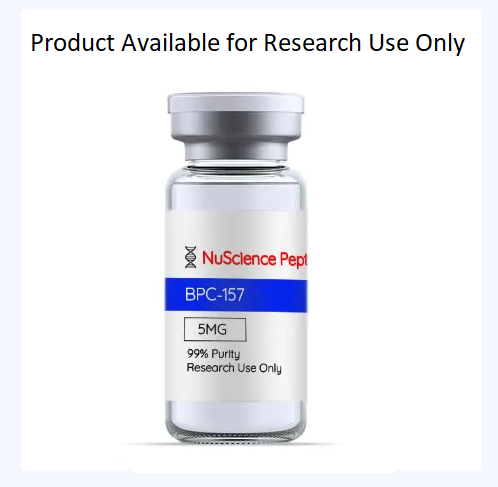BPC 157 peptide is significantly gaining attention among researchers for its potential therapeutic applications. It’s a naturally occurring peptide found in the human gastric juice.
If you are also a researcher interested in BPC 157 peptide, this article is just for you.
We’ll first discuss the scientific background of BPC 157 and its potential benefits. Then we’ll explore recommended dosages and some side effects. We’ll also guide you to an authentic platform to buy BPC-157 peptide online.
So let’s start with the basics.
Part 1. What is BPC-157 Peptide and How Does it Work?
BPC 157, or Body Protection Compound, is a stable 15-amino acid fragment. This peptide is found and isolated in gastric juice.
BPC 157 is known for its significant organ-protective effects across various species. Moreover, it’s potent at very low dosages and exhibits immediate & long-lasting activity. BPC 157 showcases healing-promoting effects on multiple organ systems. These include the gastrointestinal tract, pancreas, liver, and heart. And particularly, it’s effective on injuries such as pseudoarthrosis.
More surprising is that BPC 157 peptide has no significant reported side effects. It’s water-soluble, resistant to human gastric acid, and exhibits anti-inflammatory properties. So it runs parallel to growth factors like TGF-β1 and EGF. (Chang et al. 2011)
Click here to buy BPC 157 peptide now.
Now let’s explore the benefits of BPC 157 peptide in detail!
Part 2. Research on Non-Humans: Benefits of BPC-157
Here are some of the major benefits of BPC 157 peptide. All these benefits are shown by research on non-humans.
1. Benefits to Central Nervous System
A study has illuminated the potential benefits of gastric pentadecapeptide BPC-157 on the central nervous system.
- It was observed to counteract brain damage caused by induced stroke. And it also enhances memory, locomotion, and coordination in rats.
- Furthermore, the peptide mitigated “positive-like” schizophrenia symptoms in acute and chronic models.
- Notably, it also promoted healing and functional recovery post-spinal cord compression. The absence of reported adverse effects underlines BPC-157’s potential as a therapeutic agent.
However, these findings from animal studies emphasize the need for further human trials. This is required for a comprehensive understanding of BPC-157’s benefits and safety. (Vukojevic et al. 2022)
2. Accelerated Tendon Healing and Regeneration
Research reveals that the peptide BPC-157 plays a significant role in tendon healing and recovery.
- Its action involves complex pathways and stages like inflammation, regeneration, and remodeling.
- BPC 157 has been found to accelerate the initial outgrowth of tendon fibroblasts. This is critical in the early stages of tendon regeneration. Experiments have confirmed this influence. Tendon cells treated with BPC-157 significantly increased their migratory speed.
- Moreover, BPC 157 was found to activate the phosphorylation levels of FAK and paxillin in tendon fibroblasts. These are signaling proteins that regulate cell migration. This activity suggests that BPC-157 could enhance the migratory ability of tendon fibroblasts.
Overall, all these findings suggest that BPC-157 could be a potent agent in promoting tendon healing. (Chang et al. 2011)
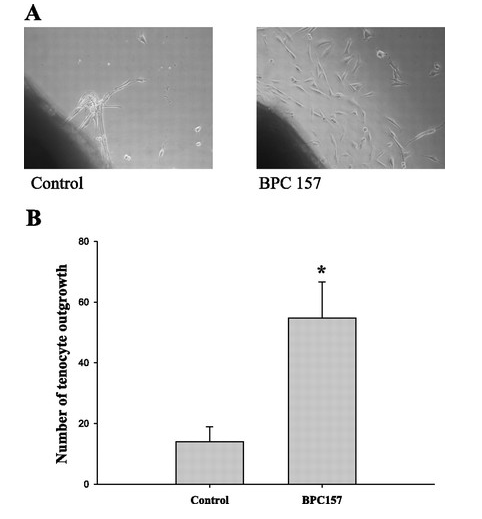
3. Wound Healing
Another research suggests that the peptide BPC-157 has profound wound-healing benefits.
- In burns, it enhances healing and reduces edema when applied topically or systemically.
- Similarly, it expedited healing in excisional wounds. This study was performed in diabetic rats and rats with artery and vein ligation.
- In tracheocutaneous and various fistulas, BPC-157 facilitated healing when given per-orally or parenterally. The effect was the closure of these defects.
So BPC 157 peptide showcases a potent, promising therapeutic influence on various wound types. And it could revolutionize wound care. (Seiwerth et al. 2021)
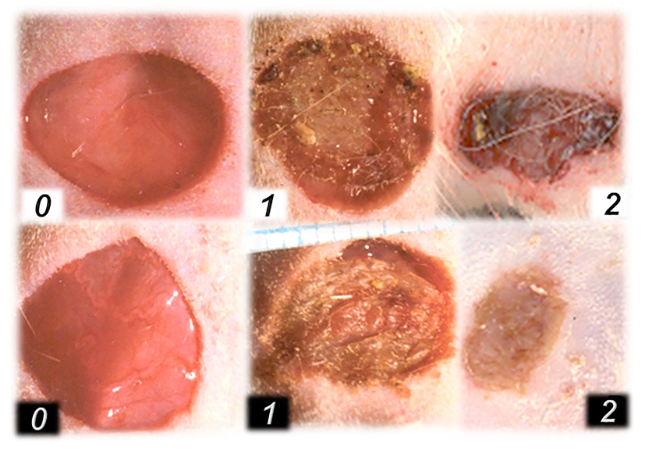
4. Improved Joint and Muscle Health
Some studies have also shown BPC 157 to be a promising candidate for treating musculoskeletal soft tissue injuries.
- It has consistently demonstrated rapid and positive healing effects on various types of tissue damage. These include tendons, ligaments, and skeletal muscles.
- Its potential extends to direct trauma injuries and systemic disorders like hyperkalemia and hypermagnesemia.
Therefore, BPC 157 could serve as a conservative treatment to aid in the functional restoration of hypo-vascular & hypo-cellular soft tissues. This will greatly relieve such debilitating conditions’ social and economic burdens. (Gwyer et al. 2019)
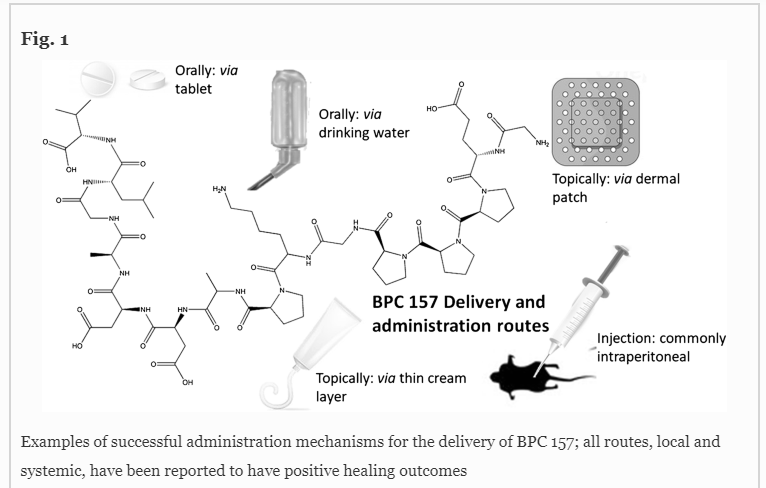
5. Enhanced Gut Health and Digestion
- BPC 157 displays remarkable protective and therapeutic effects on both acute & chronic gastric ulcers in rats.
- Whether administered intramuscularly or intragastrically, BPC-157 significantly reduces ulcer areas and accelerates healing.
- Its superiority to famotidine in inhibiting ulcer formation when administered intramuscularly is particularly noteworthy.
- Moreover, BPC 157 promotes the regeneration of glandular epithelium and the formation of granulation tissue. These are vital steps in ulcer healing. (Xue et al. 2004)
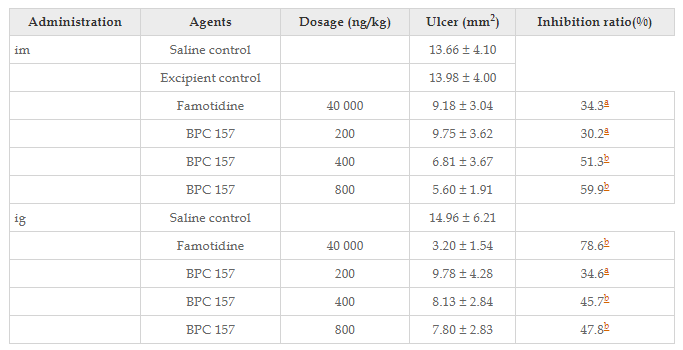
6. A Potential Rescuer of Thrombocyte Function
- Another study has shown BPC-157 to counteract the inhibitory effects of certain antithrombotic agents like aspirin, clopidogrel, and cilostazol on platelet aggregation in rats.
- This implies a restorative effect on thrombocyte function.
BPC 157’s ability to restore normal platelet function could be useful in conditions where platelet activity is compromised due to certain medications or other factors. (Konosic et al. 2019)
All of these are the major benefits of BPC-157 peptides.
But remember that nothing in this world is free of flaws. However, BPC has not shown any prominent side effects. There are some potential effects that we should be aware of.
Part 3. Potential Side Effects of BPC-157 Peptide
Multiple studies suggest that BPC-157 possesses beneficial effects. But its potential side effects are not well-explored.
Given its role in modulating biological processes, excessive or inappropriate usage could theoretically result in unwanted consequences.
Apart from that, users most commonly report local pain and inflammation at the injection site. However, these effects are generally not severe, particularly when administered as prescribed.
It’s important to remember that only a limited number of studies have been conducted on BPC-157. So individual reactions may vary. You may experience the following;
- cold or hot flashes,
- changes in appetite,
- fatigue,
- headaches,
- dizziness,
- any other discomfort lasting more than a week after beginning BPC-157.
In these cases, it’s advisable to consult a healthcare professional or consider discontinuing its use.
But one question still lingers around! What dosage should we use for BPC-157 peptide?
Let’s answer this now.
Part 4. Recommended Dosage of BPC-157 Peptide
It’s important to note that there is no officially recommended dosage due to the experimental nature of BPC-157. Animal studies provide some insight. But these doses may not translate directly to humans, given the differences in physiology and metabolism.
- In studies involving lab rats with gastric ulcers, significant effects were observed with intramuscular doses of BPC-157 ranging from 400 ng/kg to 800 ng/kg. Intragastric doses were also effective but at higher concentrations. (Xue et al. 2004)
- In burns, a thin layer of BPC-157 cream (1 µg/g neutral cream) can be applied once daily. (Seiwerth et al. 2021)
- For excisional wounds in diabetic rats, the same cream formulation (1 µg/1 g neutral cream) is applied immediately upon wounding. (Seiwerth et al. 2021)
- In rats with ligated iliac arteries and veins, BPC 157 was administered through drinking water. The doses used are 10 μg/kg, 10 ng/kg, 0.16 μg/ml, and 0.16 ng/ml. And a volume of 12 ml/rat/day can be used. (Seiwerth et al. 2021)
- In anecdotal human usage, a typical starting point is around 200-300 micrograms daily. Generally, it is delivered via subcutaneous injection.
Starting with a smaller dose to gauge the body’s reaction is a common practice. And then, dosage adjustments are made accordingly.
So are you ready to continue this research on BPC-157? Let’s see where you can buy the purest form of BPC-157 online!
Part 5. Buying BPC-157 Peptide Online – NuScience Peptides
Given the influx of providers purchasing BPC-157 online can be challenging. But NuScience Peptides stands out as a reliable online store for research purposes.
BPC 157 peptide from NuScience Peptides
They prioritize accurate research and offer a range of peptides and SARMs. And this, of course, includes our BPC-157. They provide
- Same-day shipping for in-stock items ordered before 12 pm EST
- Free shipping on all orders above $125.
- The dedicated team of NuScience Peptides is always ready to assist with customer service. On top of that, you can rest assured that all their products undergo rigorous lab testing.
Choose NuScience Peptides for your research needs and buy BPC 157 peptides right now.
Conclusion
The BPC 157 peptide holds immense potential for therapeutic applications. It provides diverse benefits in promoting healing, enhancing gut health, and aiding musculoskeletal recovery.
It’s a powerful tool for researchers aiming to deepen our understanding of peptide functionalities. And for top-notch purity and reliable delivery of BPC 157 for research, choose NuScience Peptides.
Their commitment to advancing scientific research guarantees you a dedicated service. Click here to buy BPC 157 peptide.
References
Belosic Halle, Z., Vlainic, J., Drmic, D., Strinic, D., Luetic, K., Sucic, M., Medvidovic-Grubisic, M., Pavelic Turudic, T., Petrovic, I., Seiwerth, S., & Sikiric, P. (2017). Class side effects: Decreased pressure in the lower oesophageal and the pyloric sphincters after the administration of dopamine antagonists, neuroleptics, anti-emetics, l-NAME, pentadecapeptide BPC 157 and l-arginine. Inflammopharmacology, 25(5), 511–522. https://doi.org/10.1007/s10787-017-0358-8
C hang, C.-H., Tsai, W.-C., Lin, M.-S., Hsu, Y.-H., & Pang, J.-H. S. (2011). The promoting effect of pentadecapeptide BPC 157 on tendon healing involves tendon outgrowth, cell survival, and cell migration. Journal of Applied Physiology, 110(3), 774–780. https://doi.org/10.1152/japplphysiol.00945.2010
Gwyer, D., Wragg, N. M., & Wilson, S. L. (2019). Gastric pentadecapeptide body protection compound BPC 157 and its role in accelerating musculoskeletal soft tissue healing. Cell and Tissue Research, 377(2), 153–159. https://doi.org/10.1007/s00441-019-03016-8
Konosic, S., Petricevic, M., Ivancan, V., Konosic, L., Goluza, E., Krtalic, B., Drmic, D., Stupnisek, M., Seiwerth, S., & Sikiric, P. (2019). Intragastric application of aspirin, clopidogrel, cilostazol, and BPC 157 in rats: Platelet aggregation and blood clot. Oxidative Medicine and Cellular Longevity, 2019, 1–9. https://doi.org/10.1155/2019/9084643
Seiwerth, S., Milavic, M., Vukojevic, J., Gojkovic, S., Krezic, I., Vuletic, L. B., Pavlov, K. H., Petrovic, A., Sikiric, S., Vranes, H., Prtoric, A., Zizek, H., Durasin, T., Dobric, I., Staresinic, M., Strbe, S., Knezevic, M., Sola, M., Kokot, A., … Sikiric, P. (2021). Stable gastric pentadecapeptide BPC 157 and wound healing. Frontiers in Pharmacology, 12. https://doi.org/10.3389/fphar.2021.627533
Vukojevic, J., Milavić, M., Perović, D., Ilić, S., Čilić, A., Đuran, N., Štrbe, S., Zoričić, Z., Filipčić, I., Brečić, P., Seiverth, S., & Sikirić, P. (2022). Pentadecapeptide BPC 157 and the central nervous system. Neural Regeneration Research, 17(3), 482. https://doi.org/10.4103/1673-5374.32096
Xue, X.-C., Wu, Y.-J., Gao, M.-T., Li, W.-G., Zhao, N., Wang, Z.-L., Bao, C.-J., Yan, Z., & Zhang, Y.-Q. (2004). Protective effects of pentadecapeptide BPC 157 on gastric ulcer in rats. World Journal of Gastroenterology, 10(7), 1032. https://doi.org/10.3748/wjg.v10.i7.1032
FDA Disclaimer
THE INFORMATION PRESENTED IN THIS ARTICLE IS PROVIDED FOR EDUCATIONAL AND INFORMATIONAL PURPOSES ONLY. The US Food & Drug Administration has not assessed the statements about BPC 157 peptide here. The BPC 157 peptide and any related products discussed are not intended to diagnose, cure, or prevent any disease. The products mentioned in this article are designed for in-vitro research only, conducted outside the human body. These products are not medicines or drugs. And the FDA has not endorsed them for any medical condition or ailment treatment. Any bodily introduction into humans or animals is strictly prohibited by law.

